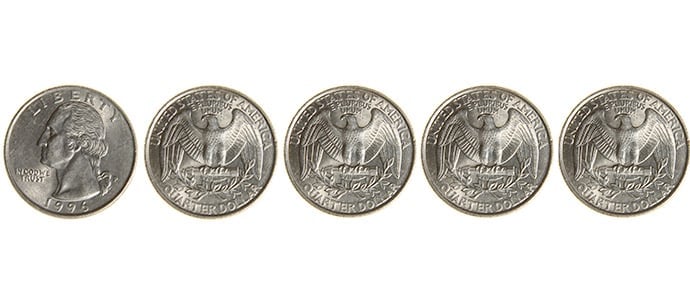Did you ever have math homework with a list of questions look like 567-68 or 11x – 73/3 = 5 ?
These are great problems for building basic math skills used all the way on up through college. But to be a top problem solver, it is a good idea to also practice questions that don’t necessarily require any of these skills. They are the kinds of questions that allow you to play around and come up with your own method of arriving at a solution. Try out the following three for starters:
- Five coins lie on a table. One of them is heads up and the other four heads down. In one move, we are allowed to flip exactly 3 coins. Use exactly two moves to face all five coins heads up. (Source: Berkeley Math Circle grades 1-2)
- Kara noticed that the sum of her age, her mom’s age and her dad’s age equals to 70. She is wondering when the sum of their ages will be equal to 100. Please help her find the solution. (Source: UCLA Elementary Math Circle archives)
- John made a building out of cubes. In the picture below, you see this building from above. In each cell you see the number of cubes in that particular tower. When you look from the front what do you see? Draw a picture. (Source UCLA Elementary Math Circle archives)

These three questions might be posed at a math circle for elementary students and require little, if any, background knowledge. However, even most high school students have to stop and jot down a few ideas before coming up with solutions.
Even at more advanced math circles for middle and high school students, the formulas that we usually learn in school are often of little help. Instead, we are left to our own devices to creatively come up with solutions. In fact, it is often the case that students who do not enjoy math class at all during the school day, love the challenges presented at math circles.
So what are math circles and where are they found?
To answer the first question, math circles are an Eastern European and Russian tradition in which pre-college students come together and have fun discussing and solving intriguing math questions in a group led by one or more mathematical professionals. They originated in Bulgaria in the early 1900s, appeared in Russia in the 1930s, and made their way to the United States in the late 1990s. Their goal is to connect students that enjoy solving problems with professional mathematicians so as to inspire them to become passionate about mathematics and to realize the beauty of the subject.
Now, in 2016, there are over 200 registered math circles around the United States, so there may indeed be one near you. In many cases they begin on university campuses and then branch off into surrounding communities.
Math circles often feed into, and motivate, other math-centered events including math olympiads and math festivals, all providing students with fun challenges that emphasize creative problem solving strategies. In the case that there is not a math circle already held in your area, there is an online circle called Camp Euclid, as well as math circle summer camps across the country.
Families can even join the growing numbers that begin their own math circles after discovering books such as Logic Camp and Playing with Mathematics, though these usually lack the guidance of a professional mathematician. Regardless of whether or not you have access to a math circle, those interested in this style of question, and even entering math competitions, can take a look at Math Kangaroo online.
Curious about the answers to the three questions at the beginning of this article? It would be unmathcircle-like to give out solutions, however here are a couple of ideas to consider:
Question 1: Do not hesitate to turn over the coin that is already heads up; sometimes taking a step backwards helps to continue forwards.
Question 2: Many people get distracted trying to calculate the ages of each family member. Instead, focus on the sum of the ages in both scenarios, as well as the number of family members.
Question 3: Try using legos or other building blocks to create this structure and simply record how many blocks are going from front to back in each row.
Learn More
National Association of Math Circles
UCLA Math Circle archive
http://www.math.ucla.edu/~radko/circles/archive.shtml
Mathematical Circle Topics
http://www.geometer.org/mathcircles/
Math Kangaroo
http://www.mathkangaroo.org/mk/default.html
Bay Area Math Olympiad Archives
Julia Robinson Math Festival
Math From Three to Seven
http://www.amazon.com/Math-Three-Seven-Mathematical-Preschoolers/dp/082186873X
Natural Math
NRICH
http://nrich.maths.org/frontpage

